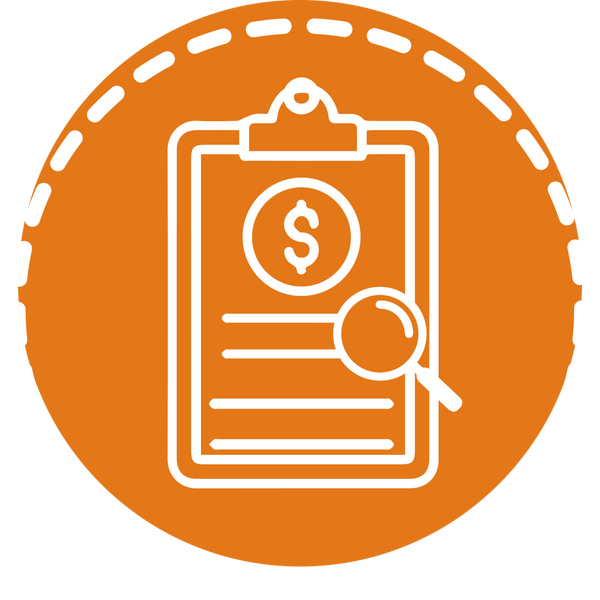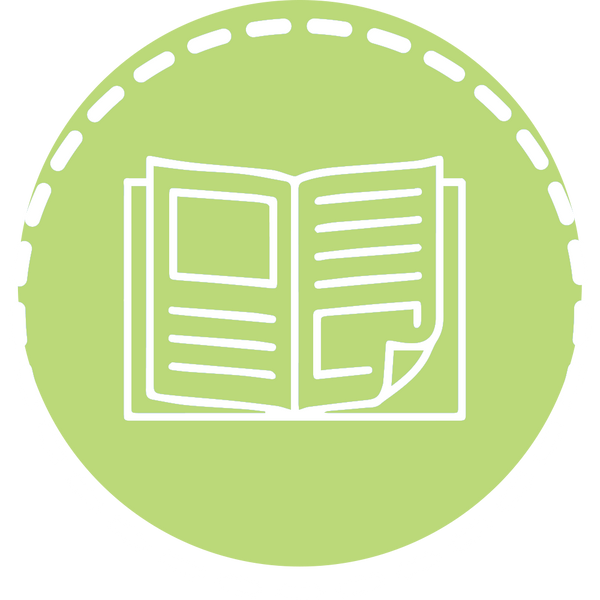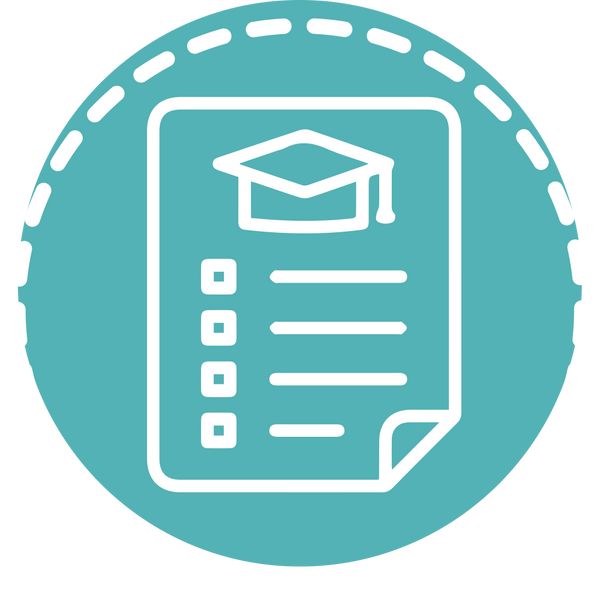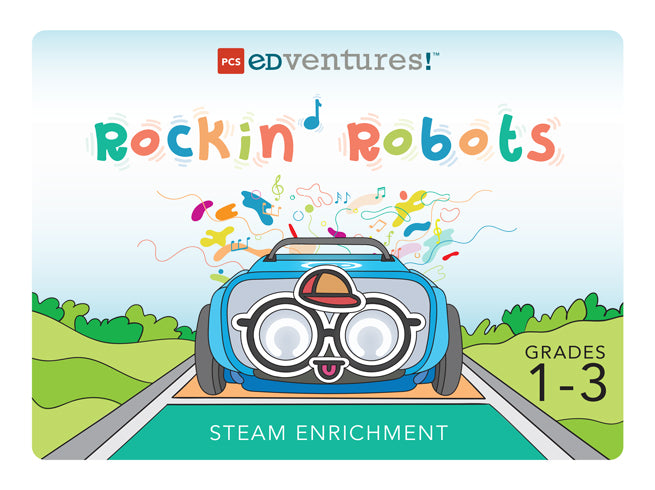

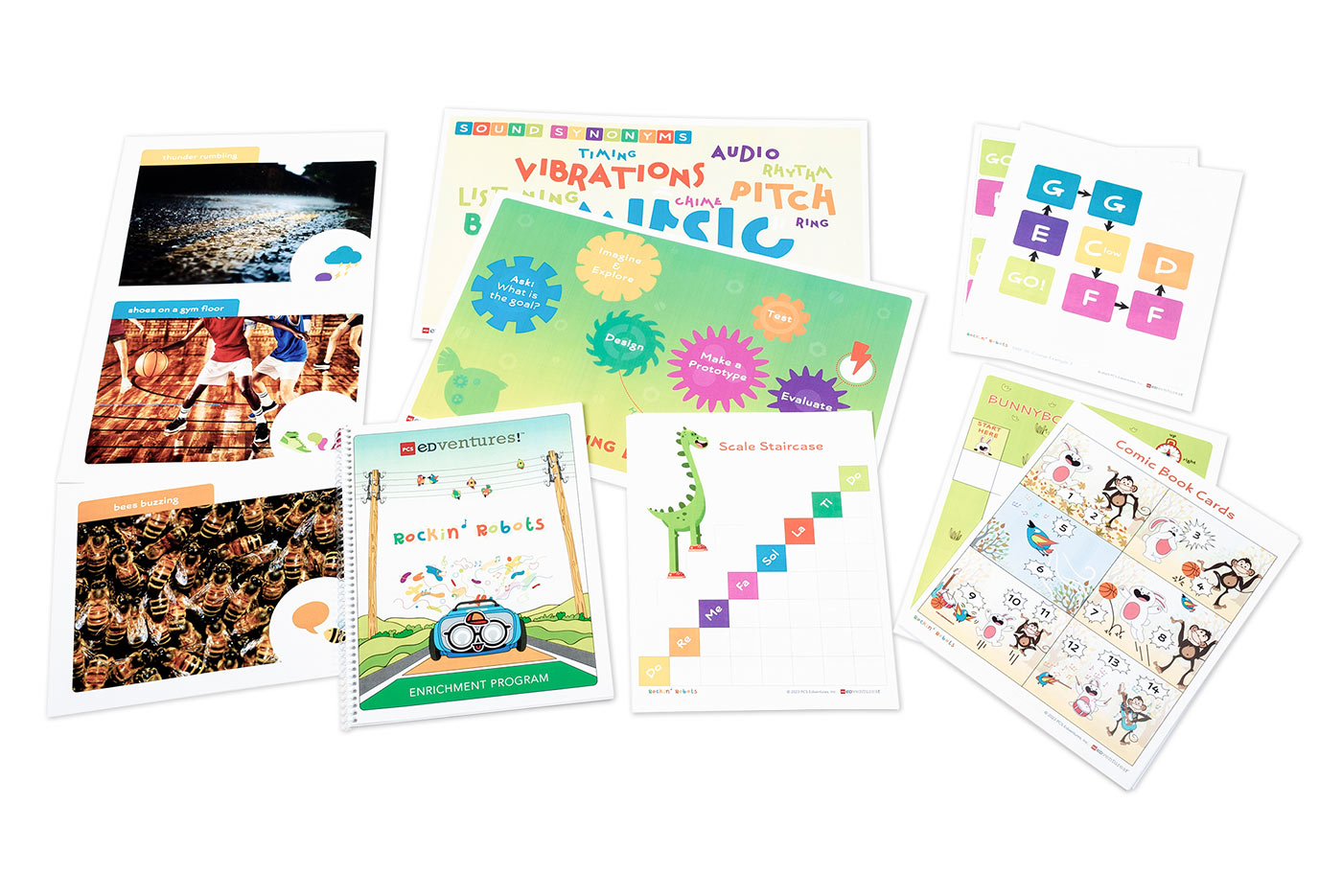
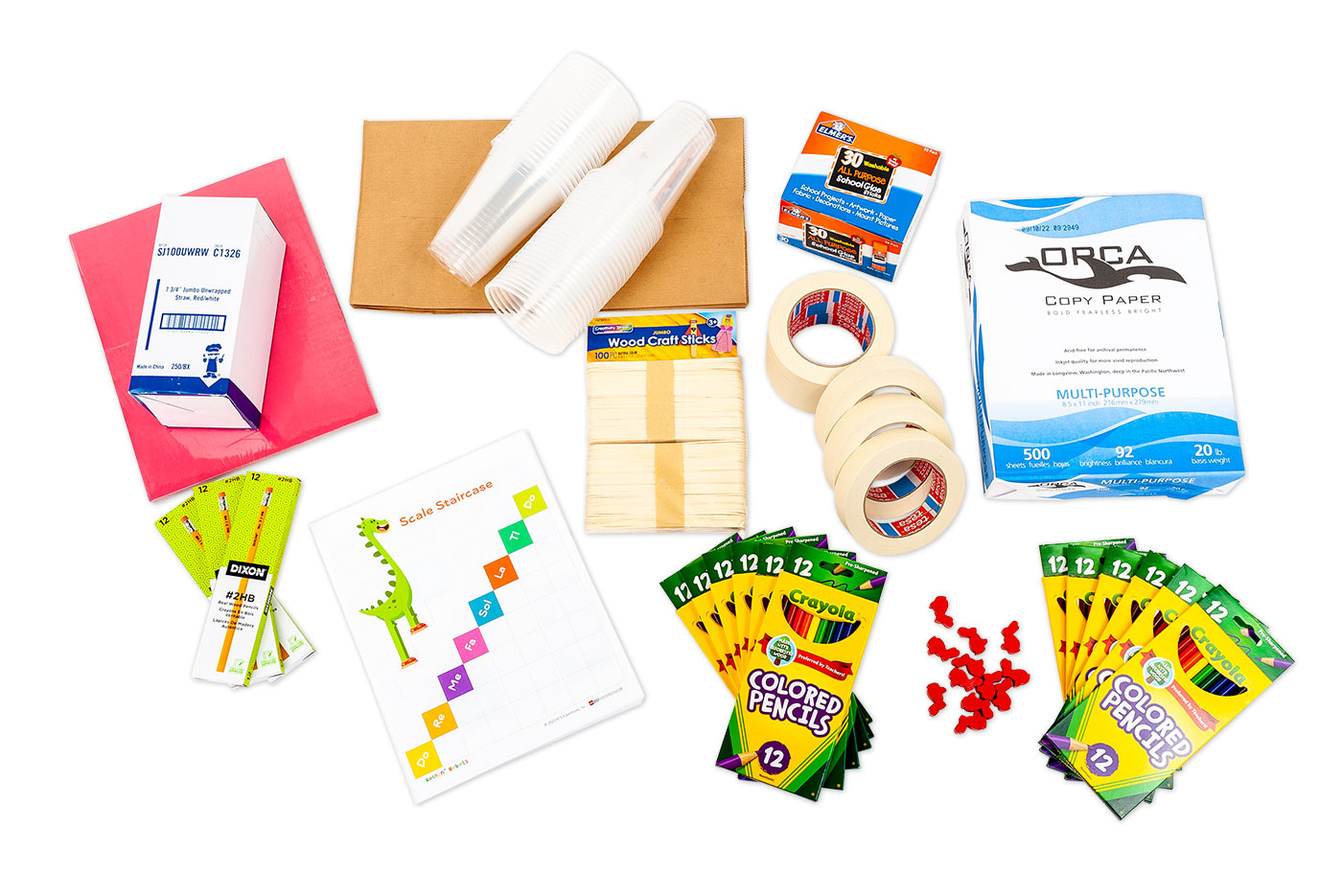
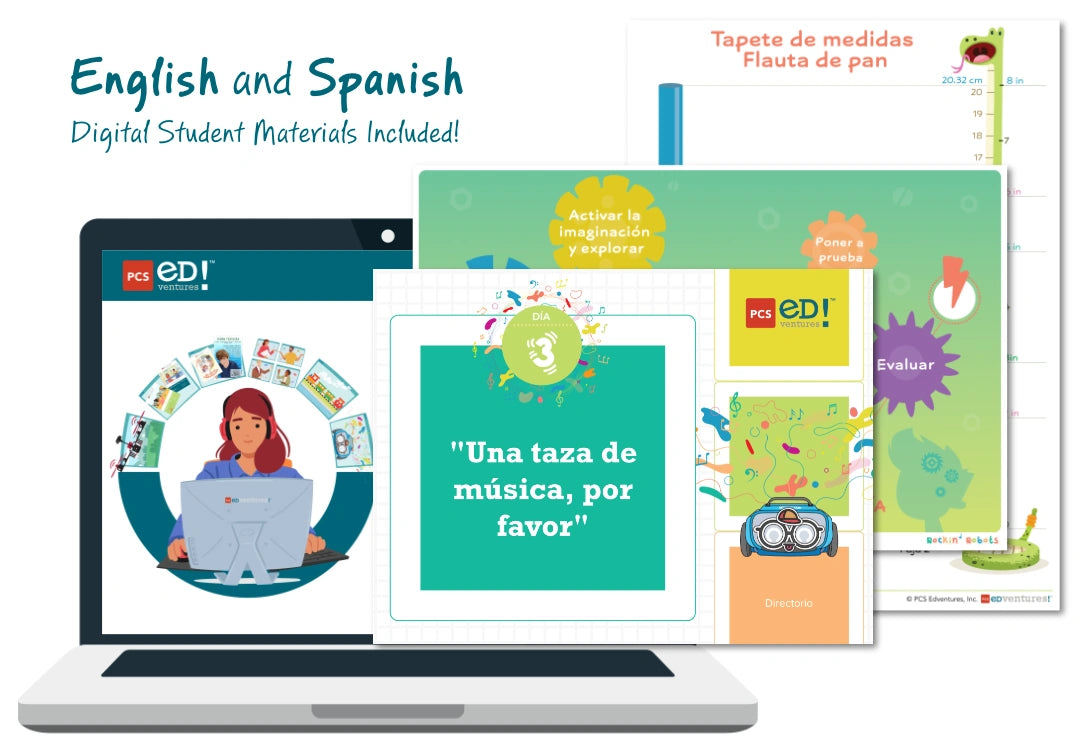
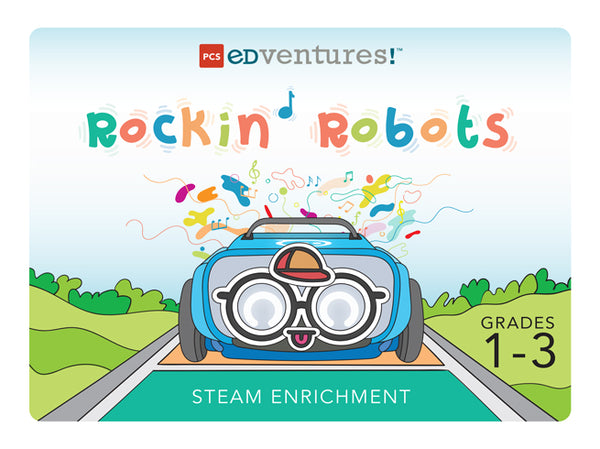
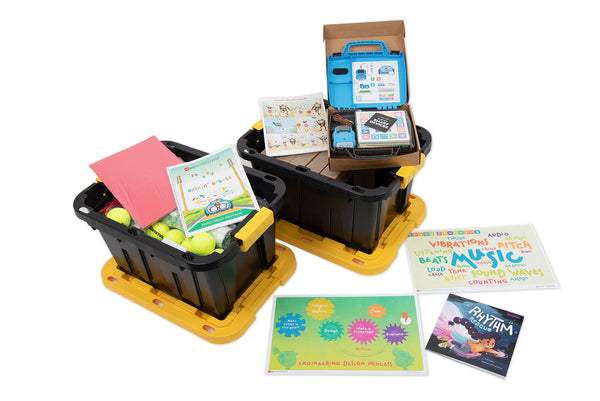
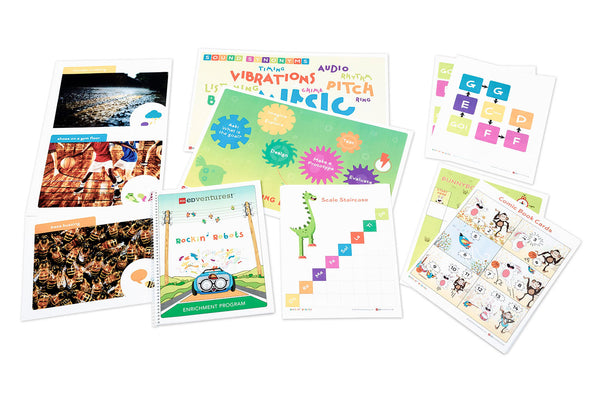
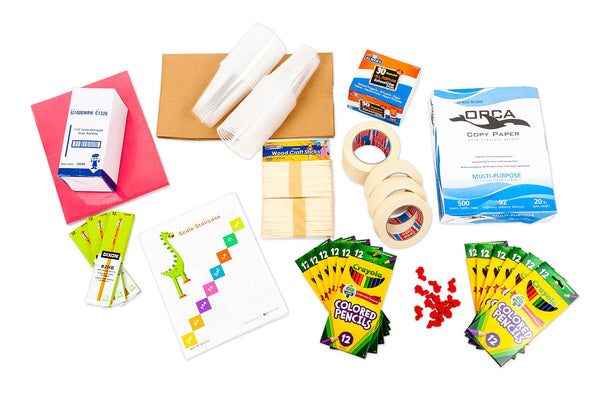
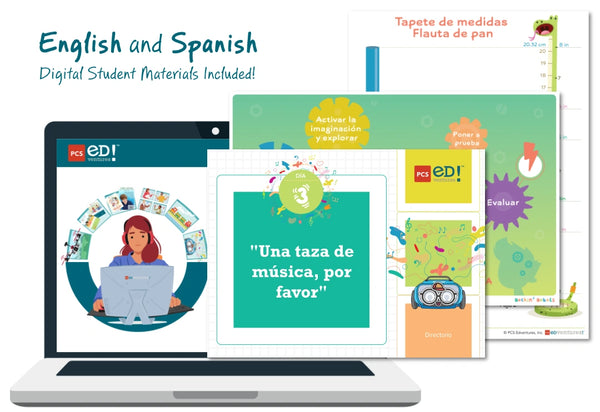







Rockin' Robots
- Sale price
- 2,495 USD
- List price
- 2,695 USD
- You save
- 200 USD (8%)
Bring Music to Life with Coding
Calling all programmers and musicians! Rockin' Robots is your chance to use Sphero indi robots on a guided tour through the STEAMtastic fusion of music and robotics. If exploring songs, crafting instruments, investigating sound effects and designing a melodic coding challenge sounds fun, then this is the camp for you!
Grades: 1-3
Students: Up to 30
Contact Hours: 12+
Subject Targets:
Technology, Robotics, Coding, Art/STEAM, English Language Arts Connections
Reusability and Expansion:
- Refill Kit Available: This product offers affordable consumable refill kits. See the materials tab for details.
🌐 Includes English and Spanish digital student materials.
Settings & Tech Requirements
Recommended Settings:
- Summer Camps
- Classrooms
- Out-of-School Time Programs
- Libraries & Makerspaces
Tech Requirements:
- 6 Tablets or Chromebooks with the Sphero Edu Jr app downloaded
Curriculum Topics
Each Activity Guide Includes:
- Topic Background Information
- Schedule
- Materials List
- Optional Extension Activities
Curriculum Topics:
- Sound Effects
- Physical Properties
- Drums
- Pan Flutes
- Driving Robots
- Practical Coding Activities
- Coding Sphero indi Robots
- Music Scale
- Song Components
- Practice Music Courses
- Music Course Design
- Music Course Assembly
Professional Development
Product Orientation:
- Half hour free webinar orientation for purchases of $500+
- One hour free webinar orientation for purchases of $1000+
- Additional training available for purchase
Materials
Complete Program Includes:
- Instructor Guide: 1
- Printed Student Pages: 6 sets
- Printed Posters: 2
- Storage Tubs: 2
- Aluminum Foil Squares (500 pack): 1
- Paper Bags: 6
- Ping Pong Balls: 12
- Tennis Balls: 6
- Rhythm Rescue by Vicky Weber: 1
- Bag of Chenille Stems: 1
- 16oz Plastic Cups: 50
- Glue Sticks: 30
- Printer Paper (500 pack): 1
- Construction Paper (50 pack): 1
- Pencils (12 pk): 3
- Colored Pencils (12 pack): 12
- Pencil Sharpeners: 6
- Rabbit Game Pieces: 12
- Rubberband (250 pack): 1
- Scissors: 30
- Straws: 250
- Sphero indi Educational Robot Student Kit: 6
- Surge Protector w/USB: 1
- Craft Sticks (100 pack): 1
- Masking Tape (60 yards): 6
- Access to the Digital Resource Portal, including English and Spanish versions of the digital student materials
Curriculum Print & Digital Includes:
- Instructor Guide: 1
- Printed Student Pages: 6 sets
- Printed Posters: 2
- Access to the Digital Resource Portal, including English and Spanish versions of the digital student materials
Refill Kit:
Ready to use your Rockin’ Robots package with another group of musical coding enthusiasts? This refill kit will get the music playing!
- Paper Bags: 6
- 16oz Plastic Cups: 50
- Glue Sticks: 30
- Printer Paper (500 pack): 1
- Construction Paper (50 pack): 1
- Pencils (12 pack): 3
- Colored Pencils (12 pack): 12
- Rabbit Game Pieces: 12
- Straws: 250
- Craft Sticks (100 pack): 1
- Masking Tape (60 yards): 6
Standards & Alignment
Habits of Mind:
16 thinking habits developed by Art Costa and Bena Kallick to empower students to succeed in a 21st-century learning environment.
- Persisting
- Managing Impulsivity
- Listening with Understanding and Empathy
- Thinking Flexibly
- Thinking about Thinking (Metacognition)
- Striving for Accuracy
- Questioning and Posing Problems
- Applying Past Knowledge to New Situations
- Thinking and Communicating with Clarity and Precision
- Gathering Data through All Senses
- Creating, Imagining, Innovating
- Responding with Wonderment and Awe
- Taking Responsible Risks
- Finding Humor
- Thinking Interdependently
- Remaining Open to Continuous Learning
21st Century Skills:
A set of widely-applicable abilities essential for success in the information age.
- Creativity and Innovation
- Critical Thinking and Problem Solving
- Communication and Collaboration
- Information, Media, and Technology Literacy
- Flexibility and Adaptability
- Initiative and Self-Direction
- Social and Cross-Cultural Skills
© 2018 Partnership for 21st Century Learning (P21), p21.org. All Rights Reserved. P21 was not involved in the production of this product and does not endorse it.
Common Core State Standards for Mathematics:
- CCSS.MATH.CONTENT.1.MD.A.1 Order three objects by length; compare the lengths of two objects indirectly by using a third object.
- CCSS.MATH.CONTENT.1.MD.A.2 Express the length of an object as a whole number of length units, by laying multiple copies of a shorter object (the length unit) end to end; understand that the length measurement of an object is the number of same-size length units that span it with no gaps or overlaps.
© Copyright 2010. National Governors Association Center for Best Practices and Council of Chief State School Officers. All rights reserved.
Common Core State Standards for English Language Arts:
- CCSS.ELA-LITERACY.RF.K.2 Demonstrate understanding of spoken words, syllables, and sounds.
- CCSS ELA-LITERACY.SL.1.1/ELA-LITERACY.SL.2.1/ELA-LITERACY.SL.3.1 Participate in collaborative conversations with diverse partners about grade 1-3 topics and texts with peers and adults in small and larger groups.
- CCSS.ELA-LITERACY.SL.1.5 Add drawings or other visual displays to descriptions when appropriate to clarify ideas, thoughts, and feelings.
- CCSS. ELA-Literacy.L.1.6 Use words and phrases acquired through conversations, reading and being read to, and responding to texts, including using frequently occurring conjunctions to signal simple relationships (e.g., because).
- CCSS.ELA-LITERACY.SL.2.2 Ask and answer questions about key details in a text read aloud or information presented orally or through other media.
- CCSS.ELA-LITERACY.SL.2.3 Ask and answer questions about what a speaker says in order to clarify comprehension, gather additional information, or deepen understanding of a topic or issue.
- CCSS.ELA-LITERACY.RL.2.4 Describe how words and phrases (e.g., regular beats, alliteration, rhymes, repeated lines) supply rhythm and meaning in a story, poem, or song.
- CCSS.ELA-LITERACY.L.4.5.C Demonstrate understanding of words by relating them to their opposites (antonyms) and to words with similar but not identical meanings (synonyms).
© Copyright 2010. National Governors Association Center for Best Practices and Council of Chief State School Officers. All rights reserved.
Next Generation Science Standards:*
- NGSS 1-PS4-1. Sound and Vibrating Materials
- NGSS 2-PS1-1. Investigating Properties of Matter
*Next Generation Science Standards
and NGSS is a registered trademark of WestEd. Neither WestEd nor the lead states and partners that developed the Next Generation Science Standards were involved in the production of this product, and do not endorse it.
International Society for Technology in Education:
- ISTE 1.1.c Students use technology to seek feedback that informs and improves their practice and to demonstrate their learning in a variety of ways.
- ISTE 1.1.d Empowered Learner Students understand the fundamental concepts of technology operations, demonstrate the ability to choose, use and troubleshoot current technologies and are able to transfer their knowledge to explore emerging technologies.
- ISTE 1.4 Innovative Designer Students use a variety of technologies within a design process to identify and solve problems by creating new, useful or imaginative solutions.
- ISTE 1.5.c Students break problems into component parts, extract key information, and develop descriptive models to understand complex systems or facilitate problem-solving.
- ISTE 1.5.d Students understand how automation works and use algorithmic thinking to develop a sequence of steps to create and test automated solutions.
ISTE Standards for Students, ©2016, ISTE® (International Society for Technology in Education), iste.org. All rights reserved. ISTE was not involved in the production of this product and does not endorse it.
About the Author
Jan Zatloukal
Jan is an instructional designer at PCS Edventures. He brings a BS in Education from the University of Idaho and is certified to teach secondary science and history. Whether it’s in a classroom or out in the field, Jan has no doubt that learning through play is the best means of inspiring learners to explore the exciting possibilities of STEAM. Jan’s experience includes tutoring, teaching and developing engaging
lessons in science and mathematics, engineering, robotics, programming, career exploration and computer aided design.
Shipping Information
Payment and Return Policy
Thank you for choosing PCS Edventures! We want to make your shopping experience with us a pleasant one. The following is our general policy concerning payment, returns, product shipping, and warranties.
Payment Information
We accept Purchase Orders (POs)*, checks, VISA, MasterCard, American Express, and Discover as forms of payment. During payment processing, we will verify your billing and shipping address. Please be sure that you enter your information accurately.
*Purchase Orders are subject to review by PCS Edventures. We reserve the right to accept or reject any Purchase Order at our discretion.
Shipping
PCS Edventures does not include the cost of shipping in its product pricing. Your shipping rate will depend on your delivery location.
We ship through Federal Express or United States Postal Service. Please provide a physical address for shipping. We are unable to ship to PO Boxes.
If your order requires expedited shipping, please contact our office at sales@edventures.com or (208) 343-3110.
Tax
Sales tax is automatically applied to any transaction that will ship to the states listed below. If you are tax exempt, please contact us at sales@edventures.com or (208) 343-3110.
Idaho: Sales tax is added, unless proper documentation for your exempt status is provided. This is required by the State of Idaho.
California: Sales tax is added to all transactions. This is required by the State of California.
Washington: Sales tax is added to all transactions. This is required by the State of Washington.
Georgia: Sales tax is added, unless proper documentation for your exempt status is provided. This is required by the State of Georgia.
New Jersey: Sales tax is added, unless proper documentation for your exempt status is provided. This is required by the State of New Jersey.
United States Customers: Please provide your organization’s Tax Identification Number or tax-exempt certification form as described in IRC Section 501 (c)(3) of the Code.
Order Fulfillment
Many products are assembled and packaged after an order is received. Typical order fulfillment time is 2-5 business days from your order date.
The products listed on our website contain materials that may be discontinued by our vendors without notice. Lead times to receive materials from our vendors may extend significantly due to a variety of factors. A sales representative will contact you within 48 hours if your order has been impacted by these issues or any other reason.
If your order requires expedited shipping, please contact our office at sales@edventures.com or (208) 343-3110 so we can try to accommodate your request. If you need delivery outside the continental United States, please contact us for shipping costs. We do not ship to PO Boxes.
Partial Fulfillment
PCS Edventures products are designed to be ready-to-use and accessible for any educator. This often requires some components to be sourced from third-party vendors. Occasionally, this may cause delays in order fulfillment.
In such cases, orders may be partially fulfilled to meet deadlines. A PCS Edventures representative will contact you if your order is subject to partial fulfillment. After the initial shipment, any delayed components will be shipped to you as soon as possible.
Return Policy
To return a product, you must first obtain a Return Merchandise Authorization ("RMA") number from PCS Edventures. To receive an RMA number, contact PCS Edventures at (208) 343-3110 within fifteen (15) business days of receipt of your product(s). Returned items must be received by PCS Edventures within thirty (30) calendar days after issuance of the RMA number or the return right will be forfeited and the RMA number becomes null and void.
All returned items must be returned postage prepaid and insured by you, in original packaging, in "as-shipped" condition, unopened and with all parts, accessories, and written materials included.
PCS Edventures may charge a restocking fee for returned items of up to thirty percent (30%), depending on circumstances. There may also be a product damage or missing-item fee in an amount determined by PCS Edventures for any product that is damaged, or is missing the original box, contents, accessories, and/or manuals (i.e., any product not in "as-shipped" condition).
These fees will apply unless the item was defective or damaged when shipped, you received the wrong item, or the fee is prohibited by law.
If you paid by credit card, you authorize PCS Edventures to debit your credit card for the amount of any fees required by PCS Edventures pursuant to this Return Policy.
PCS Edventures Warranty Information
1. LIMITED WARRANTY. PCS guarantees our products with a 30-day limited warranty against material or workmanship defects and will accept any defective item for refund or exchange. Unused or defective merchandise may be returned within 30 days after purchase for an exchange. THIS IS THE ONLY GUARANTEE OR WARRANTY BEING OFFERED BY PCS RELATING TO THE PRODUCTS AND SERVICES YOU PURCHASE OR RECEIVE FROM PCS. PCS MAKES NO OTHER, AND EXPRESSLY DISCLAIMS ALL, REPRESENTATIONS, WARRANTIES AND CONDITIONS, WHETHER IN WRITING, IMPLIED, OR STATUTORY, INCLUDING ANY WARRANTY OF MERCHANTABILITY OR FITNESS FOR ANY PARTICULAR PURPOSE, OR ANY WARRANTY ARISING FROM COURSE OF DEALING OR USAGE OF TRADE. EXCEPT AS OTHERWISE COVERED BY THE LIMITED WARRANTY, PRODUCTS AND SERVICES PROVIDED BY PCS ARE PROVIDED "AS IS" AND WITHOUT WARRANTY OF ANY KIND BY PCS. Manufacturers of non-PCS branded products may provide other warranties. Warranty claims for non-PCS branded products will be handled by their respective manufacturers.
2. Exclusivity of Remedy; Limitation of Liability. YOUR SOLE AND EXCLUSIVE REMEDY, AND PCS' SOLE AND EXCLUSIVE LIABILITY, FOR ANY BREACH OF WARRANTY SHALL BE YOUR RIGHT TO RECEIVE A REPLACEMENT PRODUCT. IN NO EVENT SHALL PCS BE LIABLE FOR SPECIAL, INDIRECT, INCIDENTAL, CONSEQUENTIAL OR PUNITIVE DAMAGES, INCLUDING LOST PROFITS OR LOSS OF BUSINESS, EVEN IF IT HAS BEEN ADVISED OF THE POSSIBILITY OF SUCH DAMAGES, NOR SHALL THE AGGREGATE LIABILITY OF PCS, WHETHER IN CONTRACT, WARRANTY, TORT, PRODUCT LIABILITY, STRICT LIABILITY OR OTHER THEORY, ARISING OUT OF OR RELATING TO THESE TERMS OR THE PURCHASE OR USE OF ANY PRODUCTS EXCEED THE PURCHASE PRICE OF THE PRODUCT. ANY LEGAL ACTION AGAINST PCS FOR BREACH OF THESE TERMS OF SALE, INCLUDING ANY WARRANTIES, MUST BE INSTITUTED WITHIN ONE YEAR AFTER DELIVERY OF GOODS.
3. Governing Law. The warranty terms are governed by the laws of the State of Idaho and the state courts of Idaho.
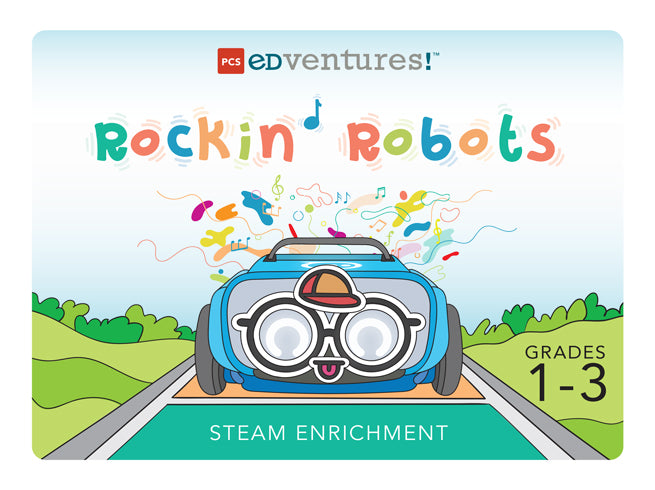
Rockin' Robots
Pricing Options:
- Complete Program (Materials + Curriculum): 2,695.00 USD 2,495.00 USD
- Curriculum Print & Digital: 425.00 USD 395.00 USD
- Refill Kit: 215.00 USD
Recommended Settings:
- Summer Camps
- Classrooms
- Out-of-School Time Programs
- Libraries & Makerspaces
Tech Requirements:
- 6 Tablets or Chromebooks with the Sphero Edu Jr app downloaded
Each Activity Guide Includes:
- Topic Background Information
- Schedule
- Materials List
- Optional Extension Activities
Curriculum Topics:
- Sound Effects
- Physical Properties
- Drums
- Pan Flutes
- Driving Robots
- Practical Coding Activities
- Coding Sphero indi Robots
- Music Scale
- Song Components
- Practice Music Courses
- Music Course Design
- Music Course Assembly
Product Orientation:
- Half hour free webinar orientation for purchases of $500+
- One hour free webinar orientation for purchases of $1000+
- Additional training available for purchase
Complete Program Includes:
- Instructor Guide: 1
- Printed Student Pages: 6 sets
- Printed Posters: 2
- Storage Tubs: 2
- Aluminum Foil Squares (500 pack): 1
- Paper Bags: 6
- Ping Pong Balls: 12
- Tennis Balls: 6
- Rhythm Rescue by Vicky Weber: 1
- Bag of Chenille Stems: 1
- 16oz Plastic Cups: 50
- Glue Sticks: 30
- Printer Paper (500 pack): 1
- Construction Paper (50 pack): 1
- Pencils (12 pk): 3
- Colored Pencils (12 pack): 12
- Pencil Sharpeners: 6
- Rabbit Game Pieces: 12
- Rubberband (250 pack): 1
- Scissors: 30
- Straws: 250
- Sphero indi Educational Robot Student Kit: 6
- Surge Protector w/USB: 1
- Craft Sticks (100 pack): 1
- Masking Tape (60 yards): 6
- Access to the Digital Resource Portal, including English and Spanish versions of the digital student materials
Curriculum Print & Digital Includes:
- Instructor Guide: 1
- Printed Student Pages: 6 sets
- Printed Posters: 2
- Access to the Digital Resource Portal, including English and Spanish versions of the digital student materials
Refill Kit:
Ready to use your Rockin’ Robots package with another group of musical coding enthusiasts? This refill kit will get the music playing!
- Paper Bags: 6
- 16oz Plastic Cups: 50
- Glue Sticks: 30
- Printer Paper (500 pack): 1
- Construction Paper (50 pack): 1
- Pencils (12 pack): 3
- Colored Pencils (12 pack): 12
- Rabbit Game Pieces: 12
- Straws: 250
- Craft Sticks (100 pack): 1
- Masking Tape (60 yards): 6
Habits of Mind:
16 thinking habits developed by Art Costa and Bena Kallick to empower students to succeed in a 21st-century learning environment.
- Persisting
- Managing Impulsivity
- Listening with Understanding and Empathy
- Thinking Flexibly
- Thinking about Thinking (Metacognition)
- Striving for Accuracy
- Questioning and Posing Problems
- Applying Past Knowledge to New Situations
- Thinking and Communicating with Clarity and Precision
- Gathering Data through All Senses
- Creating, Imagining, Innovating
- Responding with Wonderment and Awe
- Taking Responsible Risks
- Finding Humor
- Thinking Interdependently
- Remaining Open to Continuous Learning
21st Century Skills:
A set of widely-applicable abilities essential for success in the information age.
- Creativity and Innovation
- Critical Thinking and Problem Solving
- Communication and Collaboration
- Information, Media, and Technology Literacy
- Flexibility and Adaptability
- Initiative and Self-Direction
- Social and Cross-Cultural Skills
© 2018 Partnership for 21st Century Learning (P21), p21.org. All Rights Reserved. P21 was not involved in the production of this product and does not endorse it.
Common Core State Standards for Mathematics:
- CCSS.MATH.CONTENT.1.MD.A.1 Order three objects by length; compare the lengths of two objects indirectly by using a third object.
- CCSS.MATH.CONTENT.1.MD.A.2 Express the length of an object as a whole number of length units, by laying multiple copies of a shorter object (the length unit) end to end; understand that the length measurement of an object is the number of same-size length units that span it with no gaps or overlaps.
© Copyright 2010. National Governors Association Center for Best Practices and Council of Chief State School Officers. All rights reserved.
Common Core State Standards for English Language Arts:
- CCSS.ELA-LITERACY.RF.K.2 Demonstrate understanding of spoken words, syllables, and sounds.
- CCSS ELA-LITERACY.SL.1.1/ELA-LITERACY.SL.2.1/ELA-LITERACY.SL.3.1 Participate in collaborative conversations with diverse partners about grade 1-3 topics and texts with peers and adults in small and larger groups.
- CCSS.ELA-LITERACY.SL.1.5 Add drawings or other visual displays to descriptions when appropriate to clarify ideas, thoughts, and feelings.
- CCSS. ELA-Literacy.L.1.6 Use words and phrases acquired through conversations, reading and being read to, and responding to texts, including using frequently occurring conjunctions to signal simple relationships (e.g., because).
- CCSS.ELA-LITERACY.SL.2.2 Ask and answer questions about key details in a text read aloud or information presented orally or through other media.
- CCSS.ELA-LITERACY.SL.2.3 Ask and answer questions about what a speaker says in order to clarify comprehension, gather additional information, or deepen understanding of a topic or issue.
- CCSS.ELA-LITERACY.RL.2.4 Describe how words and phrases (e.g., regular beats, alliteration, rhymes, repeated lines) supply rhythm and meaning in a story, poem, or song.
- CCSS.ELA-LITERACY.L.4.5.C Demonstrate understanding of words by relating them to their opposites (antonyms) and to words with similar but not identical meanings (synonyms).
© Copyright 2010. National Governors Association Center for Best Practices and Council of Chief State School Officers. All rights reserved.
Next Generation Science Standards:*
- NGSS 1-PS4-1. Sound and Vibrating Materials
- NGSS 2-PS1-1. Investigating Properties of Matter
*Next Generation Science Standards
and NGSS is a registered trademark of WestEd. Neither WestEd nor the lead states and partners that developed the Next Generation Science Standards were involved in the production of this product, and do not endorse it.
International Society for Technology in Education:
- ISTE 1.1.c Students use technology to seek feedback that informs and improves their practice and to demonstrate their learning in a variety of ways.
- ISTE 1.1.d Empowered Learner Students understand the fundamental concepts of technology operations, demonstrate the ability to choose, use and troubleshoot current technologies and are able to transfer their knowledge to explore emerging technologies.
- ISTE 1.4 Innovative Designer Students use a variety of technologies within a design process to identify and solve problems by creating new, useful or imaginative solutions.
- ISTE 1.5.c Students break problems into component parts, extract key information, and develop descriptive models to understand complex systems or facilitate problem-solving.
- ISTE 1.5.d Students understand how automation works and use algorithmic thinking to develop a sequence of steps to create and test automated solutions.
ISTE Standards for Students, ©2016, ISTE® (International Society for Technology in Education), iste.org. All rights reserved. ISTE was not involved in the production of this product and does not endorse it.
Jan Zatloukal
Jan is an instructional designer at PCS Edventures. He brings a BS in Education from the University of Idaho and is certified to teach secondary science and history. Whether it’s in a classroom or out in the field, Jan has no doubt that learning through play is the best means of inspiring learners to explore the exciting possibilities of STEAM. Jan’s experience includes tutoring, teaching and developing engaging
lessons in science and mathematics, engineering, robotics, programming, career exploration and computer aided design.





